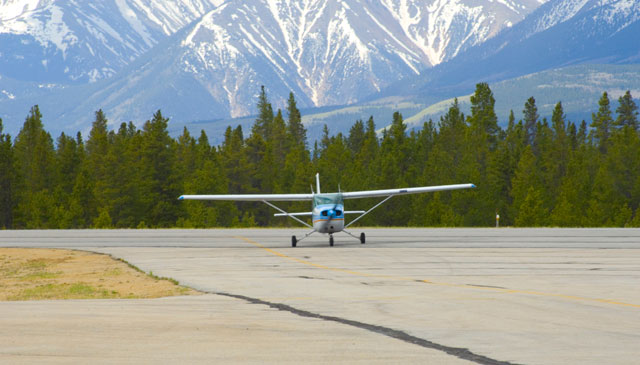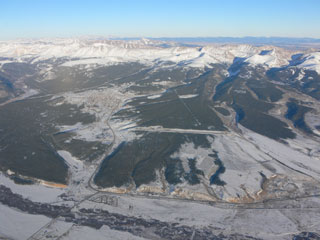Technique: In the high country
High density altitude flying in the mountains of Colorado

For the past six years I have brought our 450-horsepower Stearman to Colorado to fly airshows in the high country. I’ve flown shows from one end of the Rocky Mountains to the other and seen the West from the cockpit of an antique, open-cockpit biplane. In prior years I’ve based out of one of the airports around metropolitan Denver, but for 2012 I decided to position the airplane at Lake County Airport in Leadville, Colorado—the highest public use airport in North America, elevation 9,934 feet.
Flying in the high country is different. A textbook will tell you that high density altitude increases true airspeed and turn radius while decreasing engine and propeller performance. But it’s not just aircraft performance that makes high-country flying a challenge. By its very nature, flying in the mountains offers the potential for gusty and varying winds, significant up- and downdrafts, and summer thunderstorms.
During the four months at Leadville I had the opportunity to watch hundreds of folks fly in to receive their “Highest Airport in North America” certificate and, along with many of them, we learned a bit more about flying at these altitudes.
Remember your private pilot days and the Koch chart for adjusting takeoff performance for density altitude? If you pulled one out today and put your plotter on 20 degrees Celcius (or 68 degrees Fahrenheit at Leadville’s pressure altitude of 9,934 feet), you would see that you are off the chart for increasing takeoff distance. You need to add somewhere around 300 percent to your normal takeoff distance—but that’s the easy part. Taking off is a visual maneuver and it is those visual cues, along with feel, that we use—cross-checking the instruments, of course—to know when the airplane is ready to fly.
When I originally checked out in a stock Stearman I was taught to “climb at 80, cruise at 80, and land at 80.” The big engine is heavier than the stock airplane’s so the speeds are a bit higher, but you get the idea. At sea level with the big engine, the short-field takeoff roll in my Stearman is less than 100 yards. At Leadville it is not quite so short. At these altitudes the textbooks and POH will tell you to lean the engine for maximum power during the run-up. In reality, after landing you should note the position of the mixture prior to shutdown. Use that as a guide for engine start and taxi, then adjust for max power during the runup per the POH.
 Leadville Airport, elevation 9,934 feet.
Leadville Airport, elevation 9,934 feet.
Checklist complete and I’m on the runway. In comes the power and off we go, slowly. More forward stick pressure than normal and the tail comes up. Wow, it sure is taking a long time. My peripheral vision is telling me she should be getting ready to fly. The trees are moving past just like normal but she doesn’t feel right. I glance down and notice the airspeed is only 70 mph and the clue light comes on. At this density altitude 80 mph across the ground is less than 70 mph of airspeed. My eyes are giving me bad information. I needed to trust the gauges and put a big question mark next to those visual cues and habit patterns I brought from sea level.
I wasn’t alone in learning about taking off in the high country. One beautiful summer day a type club arrived with six or seven airplanes. They stopped at the brand-new FBO, got their certificates and T-shirts, and gassed up for the 50-mile hop over Tennessee Pass to Eagle County (Vail). It was nearly noon. The temperature was a warm 70 degrees F. Personally I wouldn’t have topped off the tanks for a 50-mile flight over the pass, but fuel prices being what they are, some folks did.
When it was time to leave, pilots from the type club hopped in their airplanes to crank up. Remember that part about noting the position of the mixture before shutdown? Two things occur at idle with the mixture full rich at 10,000 feet. Too much fuel is obvious, thus the need to lean before starting. The second is that there is very little air to mix with that lean mixture. When you taxied in you may have noticed the idle was unusually low and you may have needed to carry extra throttle to keep a normal idle. The idle setting for most aircraft is set with the aircraft at or near sea level. With the thin air at altitude and lean mixture, the need for additional throttle is typical.
During a normal start, cracking the throttle is the usual procedure for most normally aspirated engines—but in the high country, just as in after landing, more throttle and less mixture may be needed for engine start. After a few flooded engines and a few strained batteries the type club taxied to the north end for a departure off Runway 16.
Since that day I have reviewed the POH for the aircraft this group brought to Leadville, and it doesn’t have a procedure for high density altitude takeoffs. But I’m pretty sure the pilots didn’t know one either. Each aircraft took the runway with partial flaps set and released brakes with the yoke well aft. They went down the runway with the aircraft nose in the air, typical of a soft-field takeoff. Each one did exactly the same thing. Each one lifted off near the departure end of the runway and each one scared the daylights out of those of us watching. I suspect some of those pilots learned as much that day as those of us on the ground.
By applying the wrong technique for the situation, they actually increased their takeoff roll. They were plowing the air going down the runway and pulled the airplanes into ground effect before the departure end of the runway. Had it not been for the fact that the end of Runway 16 drops off into the valley, some might not have made it out of ground effect. Ultimately they all made it airborne and over the pass.
Flying in the high country offers spectacular opportunities. The scenery is unforgettable. The destinations are world-class. The visibility, like the opportunities, can be literally unlimited. For the properly trained and prepared pilot, flying in the high country is more challenging—yet no more hazardous—than flying in lower elevations, where airports are separated by longer distances and off-field landing possibilities are limited. Get prepared. Come visit us in Leadville. Enter KLXV in your GPS. You’ll love the journey and the hospitality and, like me, you’ll be back.
Gary Rower is a former U.S. Air Force pilot, a current airline pilot, and an accomplished airshow performer.


